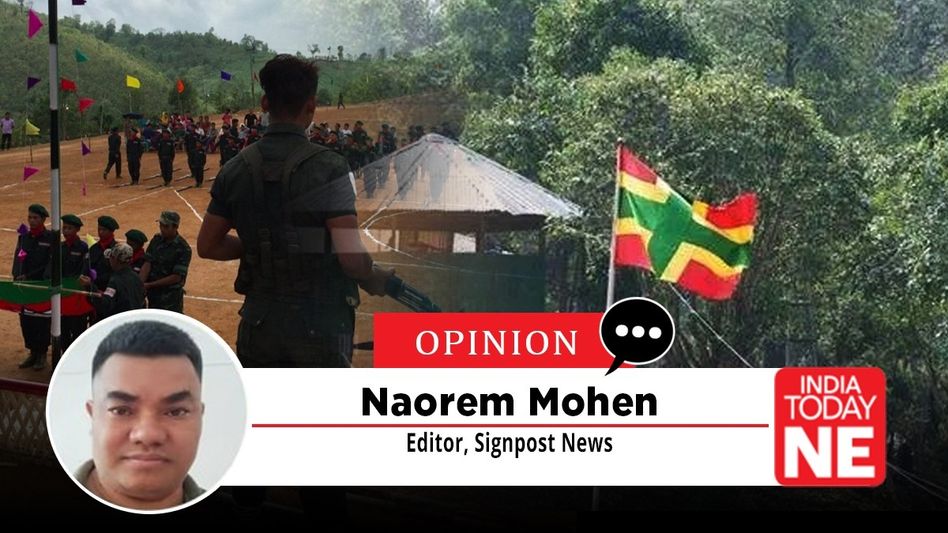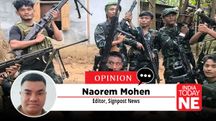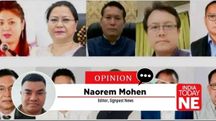How the Nampi Conclave Became a Wake‑Up Call for Meitei Civil Society
The Nampi Conclave was not theatre. It was not another round of speeches destined for the archives. It was a structural shift in how a fractured community chose to speak to power. And for the Meitei civil society organisations (CSOs), it was a mirror held up to our own disunity.

The wake‑up call did not arrive with drums or slogans. It came quietly, almost politely. While Imphal still slept, still nursing the comfort of separate press conferences and separate letterheads, the Kuki‑Zo leadership did something so disciplined, so mature, and so ruthlessly efficient that every Meitei civil society leader should have jolted upright in bed the moment the news broke.
The Nampi Conclave was not theatre. It was not another round of speeches destined for the archives. It was a structural shift in how a fractured community chose to speak to power. And for the Meitei civil society organisations (CSOs), it was a mirror held up to our own disunity.
Perhaps the most poignant moment of the Conclave was not captured in any press communiqué, yet it spoke louder than any resolution. For decades, the United Peoples’ Front (UPF) had fought and sacrificed for “Zoland,” while the Kuki National Organisation (KNO) carried the banner of “Kukiland.” Two names, two maps, two prides, two graveyards of young men who died believing the other side had betrayed the dream.
Under the rallying theme “Unity in Action: Securing Land, Legislature, and Future for the Kuki‑Zo People”, the landmark Conclave on 15–16 November 2025 in Guwahati brought together a broad cross‑section of leadership: the Kuki Zo Council (KZC), Zomi Council (ZC), Kuki Students’ Organisation (KSO), Kuki Inpi (KI), Kuki Chief Association (KCA), elected MLAs, SoO signatory groups, and distinguished experts.
Also Read: Demography May Change, But History of Manipur Does Not
Something historic unfolded. For the first time, leaders of the UPF and KNO set aside decades‑old separate identities and terminologies, took their seats side by side, and forged a unified front with one unwavering, non‑negotiable demand: Separate Administration for the Kuki‑Zo people. Delhi may have dismissed this as utopian, but the act itself was revolutionary.
They did not abandon their histories; they transcended them. They chose to move forward together precisely by agreeing to leave something on the table that each once considered sacred. That single act of mature statesmanship—sacrificing a word, a map, a slogan for the survival of an entire people—turned former rivals into partners and scattered militias into a disciplined bloc.
From now onwards, there will be only one joint committee when they sit with Delhi. They did not pretend the past never happened; they simply decided that the future of their living children was worth more than the glory of their dead slogans.
The Conclave delivered four wake‑up calls that Meitei CSOs cannot afford to ignore.
First: If people who once counted their losses in graves can change their identities in a single weekend, then Meitei civil society groups—who share the same language, the same Kangla, and the same grief for burned homes—have no excuse left for speaking through twenty different microphones.
Second: They gave the Kuki‑Zo Council—once dismissed as powerless—the authority to lead every political move from now on. No more solo delegations from Churachandpur or Kangpokpi. No more contradictory press releases issued within a day. From here on: one address, one envelope, one voice.
Third: The Conclave declared that any organisation bypassing the KZC would no longer be hailed as heroic, but condemned as a saboteur of the people. In one stroke, they transformed a dormant umbrella into a living spine.
Most radical of all was the creation of the Working Group: thirty to forty elders, church leaders, displaced mothers, former militants, students, and academics, tasked with standing between power and pain. This is no committee for photo opportunities. It carries the authority to demand files, to raise hard questions before the ink dries, to walk into any room where the future is being decided and ask, “Have you released the funds meant for the students?” It is the frustration of a people whose political future is stalled in files and finance departments, whose demands for autonomy are met with procedural delays, whose memorandums gather dust while bureaucrats debate technicalities. The Working Group ensures no leader or official can ever again claim they “didn’t know.”
Fourth: The hardest call of all—an admission of failure. The very need for Nampi was itself proof that the old model—fragmented voices, secret bargains, unaccountable warlords—had delivered two years and six months of fire and blood without shifting Delhi an inch. Instead of concealing that failure, they made it the cornerstone of reform. That act of honesty is worth more than a thousand hollow victory rallies.
Now look at ourselves. In the valley, we still treat “Yaifare” as a closing slogan rather than a daily discipline. AMUCO, our grand elder born in the dark 1990s, remains the deepest root system we have, the organisation that can shut down an Ima Keithel before the sun is fully up. COCOMI, formally launched in 2019, has become the sharpest political spear the Meitei people have ever raised, consisting of around 55 CSOs and 9 branch committees. FOCS, the youngest, arrived later with fresh eyes, digital energy, and a hunger to prove itself. Each is precious. Each has bled for us.
And yet the ordinary Meitei mother sleeping on a relief‑camp floor, the student whose classroom is now a barracks, the farmer staring at fields he cannot cross—none of them care which banner was raised first. They only want to know why, after two and a half years of unbearable pain, the three banners are still marching in parallel lines instead of locking arms. The Nampi Conclave has just exposed the luxury we can no longer afford.
For too long Meitei “unity” has been a slogan shouted at rallies, not a structure that delivers results. COCOMI claims apex status one day; AMUCO issues a statement the next that sometimes reads like a gentle correction. FOCS organises spectacular events that light up local news screens but rarely move the needle in Delhi.
Every time one of our organisations bypasses the others and rushes to Delhi with its own memorandum, we hand the Centre another excuse to play divide‑and‑rule. Every time we issue contradictory statements within the same news cycle, we confirm Delhi’s favourite narrative. Every time we allow a new “apex body” to be born every six months, we prove that the word “Coordinating” in COCOMI’s name is for name sake only.
We have giants walking among us—retired IAS officers who know Delhi’s corridors blindfolded, ex‑revolutionaries who still command respect in the shadows, women who have stared down army barrels, academics who can draft a constitutional argument before breakfast. And yet many of them are reduced to writing angry Facebook posts because no one has given them an official seat at the real table.
Imagine what would happen if we copied just one thing from Nampi tomorrow: a Meitei People’s Working Group—thirty‑five names everyone trusts, balanced by region, gender, and generation—with the power to walk into any room and say, “Explain this decision to the displaced mother from Moreh before you sign it.”
When COCOMI calls for a total shutdown but cannot explain why the last one achieved nothing, who demands answers? When a new “coordinating committee” is born every six months, who asks whether we are coordinating anything at all or merely multiplying letterheads?
Imagine if AMUCO, COCOMI, FOCS, Arambai Tenggol, AMSU, MSF, DESAM, KSA, etc and women’s body like IKAL, Nupi Samaj, UMO, Porei Leimarol, Kanglamei sat down in full public view and signed a Meitei Unity Charter with five simple clauses.
The movement demands a single, consolidated political window that encompasses all core issues, eliminating fragmented negotiations and ensuring holistic resolution. This must include one jointly selected delegation—chosen transparently by the people, not imposed by any party—to represent the collective voice in every high-level dialogue in Delhi.
Alongside this, there must be one public dashboard, fully transparent and real-time, tracking every memorandum submitted, every government response (or lack thereof), and the status of each commitment. To drive actual progress, one empowered Working Group with real teeth—equipped with binding timelines, enforcement authority, and direct access to decision-makers—must be established. Finally, one annual report card, independently prepared and publicly released, must evaluate the performance of all stakeholders, including the government, so that the people can judge their leaders with full clarity, reversing the traditional dynamic of accountability.
The Nampi Conclave has shown that unity is not the absence of disagreement; it is the presence of structures that force disagreement to be resolved before it reaches the enemy’s ears. Meitei civil society must now choose: keep enjoying the luxury of twenty voices shouting twenty different things, or build one table where twenty voices are forced to produce one coherent message.
Some will say this is impossible because Meitei society is too diverse, too democratic, too proud. That is romantic nonsense. The same argument was made by Kuki‑Zo factions who once killed each other over village boundaries. Remember Churachandpur—the infighting, the arsons, the riots over petty issues like flags. They buried the hatchet not out of sudden love, but out of cold survival arithmetic.
The Meiteis face the same arithmetic today, only with higher stakes. If we cannot centralise our political voice while the house is on fire, we will negotiate the ashes separately.
The Kuki‑Zo have not solved all their problems. Implementation will be messy. Old rivalries will resurface. But, they publicly admitted that the old model was killing them, and they replaced it with something better on paper. History will judge them by what they do next. History is already judging us by what we refuse to do now.
The Manipur crisis is no longer a law‑and‑order problem; it is an existential duel between two clear political projects. One side just sharpened its knife in full public view. The other side is still arguing about who gets to hold the knife, who gets credit for sharpening it, and whether the knife is sharp enough in the first place.
To COCOMI, AMUCO, FOCS, and every Meitei organisation that claims to speak for our survival: the Nampi Conclave is not a serendipity. It is a wake‑up call, as insistent as a fire alarm breaking the valley’s dawn. The time for sleep is over. It is the moment to form the Working Group, to unify the voice, to turn scattered banners into a single fist.
If the Kuki‑Zo could bury thirty years of conflict in a single weekend because their people demanded it, then surely we—who have never had to bury our own sons for fighting each other—can manage the same in one sitting.
The choice is stark. Either we keep multiplying letterheads while Delhi multiplies excuses, or we learn from Nampi Conclave and build a disciplined, centralised, and accountable political voice. The Kuki‑Zo have already chosen survival arithmetic. The Meiteis must now choose whether to keep arguing in the burning house—or to step outside together and negotiate the future before there is nothing left to save.
Copyright©2025 Living Media India Limited. For reprint rights: Syndications Today









